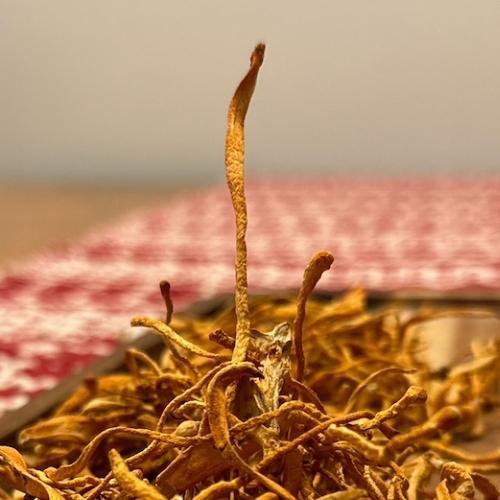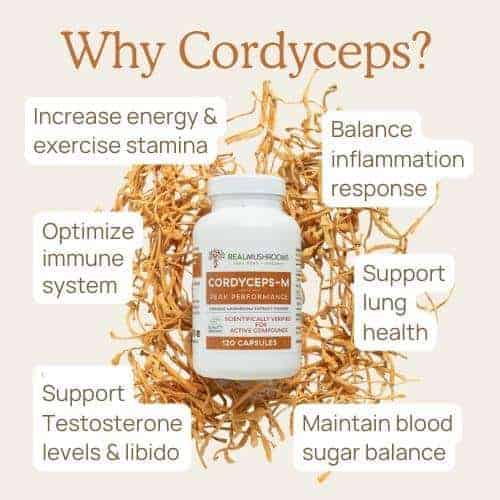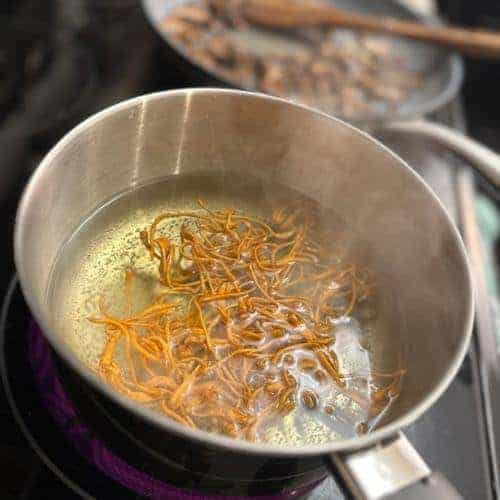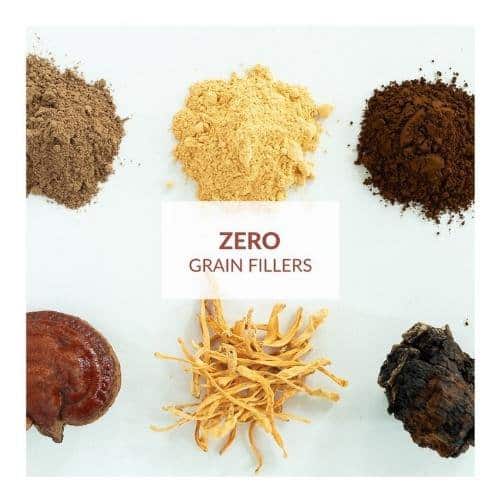Menu


If you're looking for a new way to use mushrooms in your cooking, look no further than cordyceps. This functional mushroom is gaining popularity in the culinary world for its earthy flavor and wide range of health benefits.
Eating cordyceps mushrooms, a.k.a. caterpillar mushrooms, is one way to bring diversity and color into your everyday meals. The unique nutritional profile of this mushroom also makes it a winner for the health-conscious foodie.
Cooking cordyceps is easy, and there are endless possibilities for recipes. We'll show you the simplest way to prepare cordyceps mushrooms so you can enjoy their delicious flavor and health benefits any time you want.
By the end of this article, you’ll be putting cordyceps-infused dishes as your new favorite treat.
When shopping for cordyceps mushrooms, you might notice there are two main varieties: Cordyceps sinensis and Cordyceps militaris. This type of mushroom is one of a handful of functional mushrooms used in Traditional Chinese Medicine.
The first, Cordyceps sinensis, a.k.a Himalayan gold, is a functional mushroom that grows in very few regions of the world. Additionally, Cordyceps sinensis only grows on the caterpillar of one very specific moth.
Given such precise growing circumstances, it has become so rare and sought after that the price tag is out of reach for most people (around $20,000 per kilogram!). Its alternative name clearly rings true as Cordyceps sinensis is the most expensive mushroom in the world - gold indeed!
The good news is Cordyceps militaris is a wonderful and very affordable alternative for cordyceps recipes. can be commercially cultivated on brown rice or wood substrate. This makes the cordyceps mushroom more readily available for the average consumer, and it provides the same kind of healthy compounds as the sinensis variety.
In fact, Militaris contains even higher concentrations of the key health-supporting compound, cordycepin (which will be discussed later in the article). Good news for our bodies and our wallets!
Here are a few helpful hints for your shopping excursions:

Now that you know what you’re looking for and where to buy it, why would you even want to include cordyceps in your diet in the first place? What health benefits do Cordyceps mushrooms have? And the all-important question, do they taste good?
If you like an earthy and nutty flavor with a hint of umami, then the answer is yes, cordyceps mushrooms do taste good! And if you’ve been looking for a new culinary ingredient with an abundance of health benefits, such as boosting the immune system, then eating Cordyceps is for you!
Pleasant taste and positive health support are two huge reasons to give this mushroom a try. But, if you’re not quite convinced yet, let’s dive further into the benefits of Cordyceps militaris from its nutraceutical standpoint.
First things first, what does “nutraceutical” mean? The word was first introduced by DeFelice, who combined the two words “nutrition” and “pharmaceutical” and defined it as “food or a part of food which not only impart health benefits but also contributes in preventing or treating various diseases.”
To sum it up, nutraceuticals are components found in food that play an important role in maintaining your normal physiological function and well-being [1] [2]. They’re the good stuff you want, and cordyceps has plenty of them!
In fact, cordyceps is full of nucleosides, polysaccharides, sterols, proteins, amino acids, polypeptides, and vitamins. And if you’re scratching your head trying to figure out what that means for your body and health, this table breaks it down for you.
As you can see from the table, there are various bioactive components found in Cordyceps, and they all have great therapeutic effects. Out of all of them, though, cordycepin is considered to be the most vital.
Cordyceps have a wide range of therapeutic potential. Studies have shown that taking cordyceps can support your health in the following ways [3] [4] [7]:
Talk about a small-sized mushroom with big talents!
On the nutritional side, Cordyceps militaris contains vitamins B1, B2, B12, E, and K. And that’s not all - it is abundant with proteins, fats, essential amino acids, volatile oils, carotenoids, phenolic compounds, flavonoids, and minerals (Fe, Ca, Mg, Ni, Sr, Na, Ti, Pi, Se, Mn, Zn, Al, Si, K, Cr, Ga, V and Zr).
Finally, Cordyceps militaris has different types of healthy carbohydrates like monosaccharides, oligosaccharides, sterols, nucleosides, and polysaccharides like beta-glucans, [3] [9] [5] [8] [6].
Vitamins, check. Minerals, check. A nutritional powerhouse, check. Something you probably want to include in your diet, check check!

Now that you know how beneficial this mushroom is for you, you’ll want to discover ways to use it. The great news is that cordyceps is easily prepared and can be added to many recipes to boost both taste and nutritional profile.
To show you just how easy it is to cook various cordyceps recipes, here’s a basic rundown of how to cook dried cordyceps:

Once you’ve got the basics of cooking cordyceps down, you can move on to the fun part - finding your favorite food combinations with it. The delicious taste and versatility of cordyceps mushrooms make them an easy addition to numerous meals.
If you need some help getting the creative juices going, consider adding cordyceps to these dishes:
Make your favorite version of the dishes and throw some cordyceps in it. In all cases, try to cook the cordyceps just until they soften. Otherwise, overcooking these mushrooms will turn them rubbery and will make eating cordyceps a less pleasant experience.

Although cooking cordyceps is incredibly simple, there’s an even easier route, one where you can get all those health benefits on a daily basis - without turning on the stove at all. Enter cordyceps supplements.

You can find cordyceps supplements in capsule form or as a powder to add to various cordyceps recipes. You can add the powder to your favorite tea, coffee, or hot chocolate. Or create cordyceps-infused dishes, like cordyceps soup or cordyceps pasta. There’s truly no limit to what you can do with cordyceps extracts.
If you’re looking for other creative ways to easily add cordyceps extract powder to your snacks and drinks, check out this article. At Real Mushrooms, our 100% organic mushroom extracts contain no grains or filler, ensuring you’re getting the full functional benefits of the mushroom extract you order.
Whether you decide to get creative in the kitchen and whip up some culinary masterpiece with cordyceps mushrooms, toss some on your favorite dish you’re already cooking, or go the supplement route - one thing is sure: you can’t go wrong with eating cordyceps!
1. Ahmad F., Ashraf S.A., Ahmad F.A., Ansari J.A., Siddiquee R.A. Nutraceutical Market and its Regulation. Am. J. Food Technol. 2011;6:342–347. doi: 10.3923/ajft.2011.342.347.
2. Ashraf S.A., Adnan M., Patel M., Siddiqui A.J., Sachidanandan M., Snoussi M., Hadi S. Fish-based Bioactives as Potent Nutraceuticals: Exploring the Therapeutic Perspective of Sustainable Food from the Sea. Mar. Drugs. 2020;18:265. doi: 10.3390/md18050265.
3. Elkhateeb W.A., Daba G.M., Thomas P.W., Wen T.C. Medicinal mushrooms as a new source of natural therapeutic bioactive compounds. Egypt. Pharm. J. 2019;18:88–101.
4. Bawadekji A., Al Ali K., Al Ali M. A Review of the Bioactive Compound and Medicinal Value of Cordyceps militaris. J. North Basic Appl. Sci. (JNBAS) 2016;1:69–76. doi: 10.12816/0021378.
5. Hur H. Chemical Ingredients of Cordyceps militaris. Mycobiology. 2008;36:233–235. doi: 10.4489/MYCO.2008.36.4.233.
6. Li S., Li P., Ji H. RP-HPLC determination of ergosterol in natural and cultured Cordyceps. Chin. J. Mod. Appl. Pharm. 2011;18:297–299.
7. Wang D., Zhang Y., Lu J., Wang Y., Wang J., Meng Q., Lee R.J., Teng L. Cordycepin, a Natural Antineoplastic Agent, Induces Apoptosis of Breast Cancer Cells via Caspase-dependent Pathways. Nat. Prod. Commun. 2016;11:63–68. doi: 10.1177/1934578X1601100119.
8. Yang F.Q., Feng K., Zhao J., Li S.P. Analysis of sterols and fatty acids in natural and cultured Cordyceps by one-step derivatization followed with gas chromatography-mass spectrometry. J. Pharm. Biomed. Anal. 2009;49:1172–1178. doi: 10.1016/j.jpba.2009.02.025. [PubMed] [CrossRef] [Google Scholar]
9. Zhu J.S., Halpern G.M., Jones K. The scientific rediscovery of a precious ancient Chinese herbal regimen: Cordyceps sinensis: Part II. J. Altern. Complement. Med. 1998;4:429–457. doi: 10.1089/acm.1998.4.429. [PubMed] [CrossRef] [Google Scholar]
Disclaimer: The information or products mentioned in this article are provided as information resources only, and are not to be used or relied on to diagnose, treat, cure, or prevent any disease. This information does not create any patient-doctor relationship, and should not be used as a substitute for professional diagnosis and treatment. The information is intended for health care professionals only. The statements made in this article have not been evaluated by the Food and Drug Administration. Any products mentioned are not intended to diagnose, treat, cure, or prevent any disease. The information in this article is intended for educational purposes. The information is not intended to replace medical advice offered by licensed medical physicians. Please consult your doctor or health practitioner for any medical advice.
